The BVP-1 (bojové vozidlo pěchoty or "Infantry Fighting Vehicle") was the Czechoslovak designation for the BMP-1, produced in Czechoslovalkia, with the second world's largest production of that type after USSR. The BVP-1 was coveted at exports due to its higher quality, despite a higher cost. The remainder in the late 1980s were modernized with six MD smoke grenade launchers at the rear of the turret and flotation sides-skirts/mudguards from the BVP-2. The VCP-2 became the base for many specialized vehicles, the AMB-S, SPM-85, PRAM-S, BVP-1K, BPzV "Svatava", BVP-1 "Strop", BVP-1 "Strop" (Thz LOS and PzPK Sněžka were made from the BVP-2). Remaining Czech BVP-1s are in reserve, and none went to Ukraine according to Oryx despite reported by Reuters in April 2022. It might be an error and instead the BVP-2 had been reported sent. Slovakia (which still had a modest park of BVP-1s donated 30 to Ukraine as reported on December 2022.)
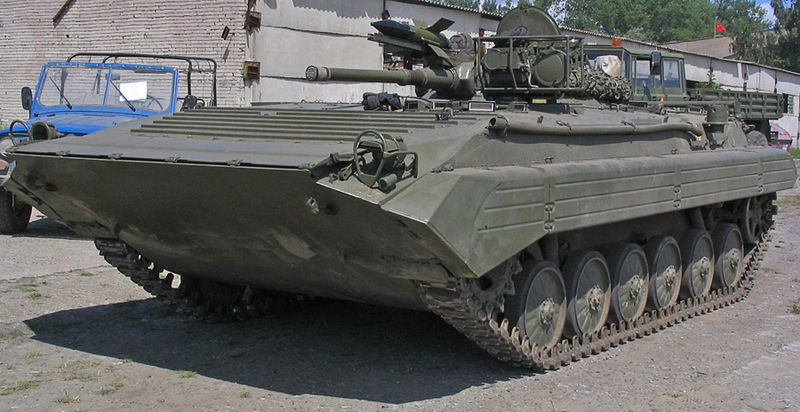
The BVP was a locally upgraded and modified version of the BMP-1 which retains the same general layout, armament, running gear, including six stamped, rubber-tired roadwheels front drive sprocket, rear track idler and three track-return rollers, same shallow glacis plate and same front-right mounted powerpack, driver, two-man turret (commander and gunner) and eight infantry at the rear, with access through back outward-opening doors.
The modern Czech Republic upgraded its park aftrer the fall of USSR and partition, giving birth to the BVP-1MA, a modernized version of the original BVP-1 which had a new German-produced one-man traversing turret with additional smoke grenade launchers "Tania". It was delined into the OT-90 M1, M2, and M3 sub-variants and stayed in service until 2022 after which 145 BVP-1 were held in storage and 185 BVP-2 to be replaced by the CV-90.
The BMP-1 was soon manufactured under license in Czechoslovakia after some modifications. Locally it was thus known as the BVP-1. At the time, Czechoslovakia had its own APCs and USSR fielded the 1950 BTR-152, a rather weak, open topped design that could be easily dealt with NATO troops. On the other hand, the BTR-50 (based on the PT-76) had also a poor armour, limited armament, and about the same disadvantages: Soldiers sat on the bed in an open space, subject to shrapnel and incompatible with new NBC protection standards. The Soviet command thus decided to develop a new armored personnel carrier, fully hermetically sealed, well protected and with enough firepower to deal with anything on the battlefield. Its frontal armor was proof against 23 mm cannon AP rounds, and the side armor was resistant to small arms fire, as the roof, and back. Competing designs were soon to be delivered at Bryansk (Object 1200), Volgograd (Object 911 and 914), Rubtsovsk (Object 19) and Chelyabinsk (Object 764).
It's Chelyabinsk Tractor Plant which initially started to work on the design by 1959. Eventually the new 73 mm 2A28 Grom cannon was tested on Object 764 and it was eventually adopted after minor modifications, being very angular, very light and fully ampibious, sharing tracks with the T-64 tank. It was produced in droves from 1966, and a contract was obtained quite quickly to produce it under licence as the BVP-1 was also produced in Czechoslovakia. It started in 1967 at ZTS Martin (engines), ZŤS Dubnica (turrets and main armament), Hriňová (lateral gears and gearboxes) with completion and tests made at ZŤS Detva and ZŤS Dubnica.
The 9K11 Maljutka (NATO AT-3 Sagger) was imported from USSR. The 1974 BMP-1M obtained the improved 9K111 Fagot (AT-4 spigot) and there was a new driver's observation device. These changes were reflected on the BVP-1 as well.
The first verification series appeared in 1968 and showed several design changes. When approved by Soviet authorities, production was greenlighted and commeced in 1970, after the line was setup. it ran until and by 1989 in two sites for different uses: This from ZŤS Dubnica nad Váhom were destined to for USSR and thos from PPS Detva were for Czechoslovakia and other Warsaw pact countries including Poland, and export at large. In Czechoslovakia, the vehicle was sometimes referred at the OT-90. The BVP-1 kept its high mobility and agility.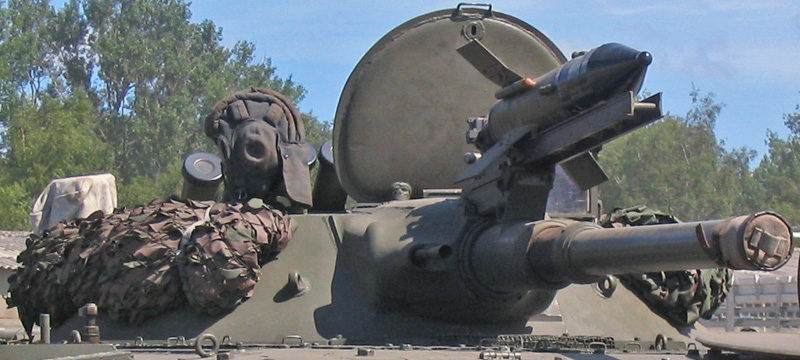
Among differences, the BVP-1 it carried the Czech manufactured 73mm cannon vz. 71, a close copy of the original 2A28 Grom cannon, fully compatible with the same ammunitions. It was coupled with a Soviet 7.62mm PKT tank machine gun with 1,000 rounds (estimated), and a single soviet-provided 9K11 Maljutka anti-tank guided missile launcher. The low pressure, smoothbore barrel gun was capable of firing the Soviet-made PG-15V and OG-15V rounds.
The PG-15V had a PG-15P small powder cartridge asa HE shell against infantry. The PG-9 reactive projectile used cumulative effect against tank (HEAT) and had a relatively small powder charge. This HEAT round had a rocket motor ignited and stabilizer flaps folding up for flight stabilization. The rotation was mostly to compensate manufacturing irregularities affecting accuracy.
The OG-15V ammunition comprises the same PG-15P small powder cartridge but a OG-9 fragmentation projectile to deal with infantry concentrations. The internal rocket had fixed stabilizer wings. The OG-15V never was in service with the Czech Army however. Loading of the gun was automatic to restrict size, and the gunner's task was to select the proper ammunition after which the loading mechanism went to pick it up and lay it down.
There are slots for two machine guns, seven submachine guns under sliding pear-shaped gun ports, on the side panels and rear doors. The BVP-1 could like the BMP-1 protect itself with a smoke screen using an oil-spreading device on the exhaust but it was also equipped when modernized by a set of eight 150x30mm smike projectors installed at the back of the turret when modernized in the 1980s.
Just like the original, the BVP-1, had a well sloped armour to defeat 23 mm AP rounds on its forward arc and small arms fire everywhere else. On the nose, the trim vane is adding an extra layer of protection on the glacis, already wedgy, making the best of its thin armour through its slope. There was hermetic sealing and a filter ventilation with overpressure as NBC protection, as well as a chemical and radiation detector, but not bacteriological. This protection was optional though as night vision for the driver.
*30 mm Strop-1 IFV variant: 6.74 x 3.15 x 2.45 m
According to a press release in December 2022, Slovakia handed over its last active batch of the 30 tracked BVP-1 to Ukraine after an equipment exchange program between the Slovak MoD and German Federal Ministry of Defense, at the time cautioous not to send direclty its own stocked BMP-1s. Since it's hard to distinguish them from regular BMP-1s, Oryx signalled some 399 BMP-1(P) so far lost by the Ukrainians. BVP-1s might be in that lot.
-The recovery tracked vehicle PVP
-The reconnaissance tracked vehicle BPzV Svatava
-The radio vehicle Bečva
-The artillery observation sets Sněžka
-The Los, a 120 mm self-propelled mortar PRAM
-The armored personnel carrier "OT-90" (one man-turret turret with 14.5 mm heavy machine gun).
Below are the details of the known variants. The VPV form was an Armored Recovery Vehicle (ARV) conversion and the SVO a mine-clearing vehicle. The OT-90 carried the OT-64A tank's primary turret as well as machine guns but lost its amphibious qualities.
The BVP-1SM is a converted armored battlefield ambulance and the BVP-1PPK / PzPK "Snezka" an artillery reconnaissance platform. The OT R-5 "Becva" is a communications vehicle and the BVP-1 LOS a dedicated tracked reconnaissance version. The one-off MGC-1 was a proposed vehicle showcasing an enhanced survivability package, armed by way of machine guns, and carried Explosive Reactive Armor (ERA) blocks.
"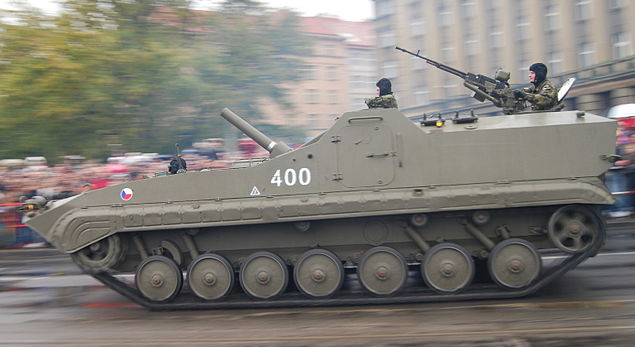
The name ShM stands for "samohybný minomet" or automated mortar. Its 120 mm Vz.1982 self-propelled mortar is indeed automatically loaded, located ion a new compartment forward, based on astreched hull with an extra pair of roadwheels. The mortar max range is 8 km. It is mounted on the BVP-1 chassis in a low casemate placed in the rear half of the vehicle for organic fire support to Czech mechanized units. The rate of fire is up to 18–20 rounds per minute but even 40 rounds in 5 minutes, 70 rounds in 10 minutes, in contant fire. It carried some 80 HE, SMK and ILL rounds. 21 are ready rounds in the automatic loader. For self-defence there is also a 9M113 Konkurs (AT-5 Spandrel) ATGM and a 12.7 mm NSVT heavy machine gun at the rear, plus RPG-75 anti-tank grenade launchers as well as F1 hand grenades and Model 58 7.62 mm submachineguns for the crew.

The BVP-1, world's second largest IFV
BMP-1s were produced under license by Czechoslovakia (BVP-1) from 1966, as the vehicle was just getting ready in state tests in USSR. A preserie was made in 1968 for conformity verification, as part of these were destined to USSR. Designs changes led to acceptation in 1970 and mass production started in 1971 until 1987. Numbers differs wildly. The BMP-1 was the first infantry fighting vehicle and probably the most common up to this day with some c20,000 made between USSR, Czechoslovakia and other countries. Like Romania, India and China (Type 86, unlicenced) just as Iran and its Boragh). In Czechoslovakia, it was made by ZTS Detva. On the 12,295 vehicles made berween Czechoslovakia and USSR, some 5,100 BVP-1 were sold to USSR as BMP-1s and some 2,074 were listed as part of the Czechoslovakian Army, so total production amounted to some 7,174 to add to the 17,295 made total in the USSR.The BVP was a locally upgraded and modified version of the BMP-1 which retains the same general layout, armament, running gear, including six stamped, rubber-tired roadwheels front drive sprocket, rear track idler and three track-return rollers, same shallow glacis plate and same front-right mounted powerpack, driver, two-man turret (commander and gunner) and eight infantry at the rear, with access through back outward-opening doors.
The modern Czech Republic upgraded its park aftrer the fall of USSR and partition, giving birth to the BVP-1MA, a modernized version of the original BVP-1 which had a new German-produced one-man traversing turret with additional smoke grenade launchers "Tania". It was delined into the OT-90 M1, M2, and M3 sub-variants and stayed in service until 2022 after which 145 BVP-1 were held in storage and 185 BVP-2 to be replaced by the CV-90.
About the Russian BMP-1
The BMP-1 (Russian: "Bojevaja Mašina Pechoty") was the first large scale production Soviet infantry fighting in the worlds. Studied in the 1960s, serial production started in 1965 and when revealed, it cause quite a schok NATO analysts, as they had nothing to compare. Even the Gerrman Panzergrenadier 20-mm cannon IFVs did not reached their abilities notably armament and armor. The BMP-1 was amphibious, swimming at 7 km per hour and boasted a low-pressure 73 mm 2A28 cannon capable of 1,300 m range to deal with infantry support, and coaxial 7.62 mm machine gun, plus a single 9M14 Maljutka anti-tank guided missile launcher over the roof with 2 km range and HEAT warhead. The BMP-1 was quickly deployed into motorized rifle units, including in Eastern and Central Europe.The BMP-1 was soon manufactured under license in Czechoslovakia after some modifications. Locally it was thus known as the BVP-1. At the time, Czechoslovakia had its own APCs and USSR fielded the 1950 BTR-152, a rather weak, open topped design that could be easily dealt with NATO troops. On the other hand, the BTR-50 (based on the PT-76) had also a poor armour, limited armament, and about the same disadvantages: Soldiers sat on the bed in an open space, subject to shrapnel and incompatible with new NBC protection standards. The Soviet command thus decided to develop a new armored personnel carrier, fully hermetically sealed, well protected and with enough firepower to deal with anything on the battlefield. Its frontal armor was proof against 23 mm cannon AP rounds, and the side armor was resistant to small arms fire, as the roof, and back. Competing designs were soon to be delivered at Bryansk (Object 1200), Volgograd (Object 911 and 914), Rubtsovsk (Object 19) and Chelyabinsk (Object 764).
It's Chelyabinsk Tractor Plant which initially started to work on the design by 1959. Eventually the new 73 mm 2A28 Grom cannon was tested on Object 764 and it was eventually adopted after minor modifications, being very angular, very light and fully ampibious, sharing tracks with the T-64 tank. It was produced in droves from 1966, and a contract was obtained quite quickly to produce it under licence as the BVP-1 was also produced in Czechoslovakia. It started in 1967 at ZTS Martin (engines), ZŤS Dubnica (turrets and main armament), Hriňová (lateral gears and gearboxes) with completion and tests made at ZŤS Detva and ZŤS Dubnica.
The 9K11 Maljutka (NATO AT-3 Sagger) was imported from USSR. The 1974 BMP-1M obtained the improved 9K111 Fagot (AT-4 spigot) and there was a new driver's observation device. These changes were reflected on the BVP-1 as well.
BVP-1 (OT-90) design
The BVP-1 was a very close copy of the Soviet BMP-1 infantry fighting vehicle, as a large part of the production was destined to USSR and another for export. A license contract was established in 1966, just as the vehicle was introduced into service. It has limited armor protection compared to a tank, but shaped were optimized, and it had a high mobility as well as a surprisingly powerful armament for its light weight. Despite this it was still able to carry a section of motorized rifle units in its rear compartment.The first verification series appeared in 1968 and showed several design changes. When approved by Soviet authorities, production was greenlighted and commeced in 1970, after the line was setup. it ran until and by 1989 in two sites for different uses: This from ZŤS Dubnica nad Váhom were destined to for USSR and thos from PPS Detva were for Czechoslovakia and other Warsaw pact countries including Poland, and export at large. In Czechoslovakia, the vehicle was sometimes referred at the OT-90. The BVP-1 kept its high mobility and agility.
Armament & protection

Among differences, the BVP-1 it carried the Czech manufactured 73mm cannon vz. 71, a close copy of the original 2A28 Grom cannon, fully compatible with the same ammunitions. It was coupled with a Soviet 7.62mm PKT tank machine gun with 1,000 rounds (estimated), and a single soviet-provided 9K11 Maljutka anti-tank guided missile launcher. The low pressure, smoothbore barrel gun was capable of firing the Soviet-made PG-15V and OG-15V rounds.
The PG-15V had a PG-15P small powder cartridge asa HE shell against infantry. The PG-9 reactive projectile used cumulative effect against tank (HEAT) and had a relatively small powder charge. This HEAT round had a rocket motor ignited and stabilizer flaps folding up for flight stabilization. The rotation was mostly to compensate manufacturing irregularities affecting accuracy.
The OG-15V ammunition comprises the same PG-15P small powder cartridge but a OG-9 fragmentation projectile to deal with infantry concentrations. The internal rocket had fixed stabilizer wings. The OG-15V never was in service with the Czech Army however. Loading of the gun was automatic to restrict size, and the gunner's task was to select the proper ammunition after which the loading mechanism went to pick it up and lay it down.
There are slots for two machine guns, seven submachine guns under sliding pear-shaped gun ports, on the side panels and rear doors. The BVP-1 could like the BMP-1 protect itself with a smoke screen using an oil-spreading device on the exhaust but it was also equipped when modernized by a set of eight 150x30mm smike projectors installed at the back of the turret when modernized in the 1980s.
Just like the original, the BVP-1, had a well sloped armour to defeat 23 mm AP rounds on its forward arc and small arms fire everywhere else. On the nose, the trim vane is adding an extra layer of protection on the glacis, already wedgy, making the best of its thin armour through its slope. There was hermetic sealing and a filter ventilation with overpressure as NBC protection, as well as a chemical and radiation detector, but not bacteriological. This protection was optional though as night vision for the driver.
BVP-1 specifications | |
| Dimensions | 6.73 x 2.94 x 2.06 m (22.1 x 10.3 x 8ft)* |
| Total weight | 13.25 t standard, 16.5 tons (33,069 lb) max load |
| Crew | 3+8 |
| Propulsion | Diesel engine UTD–20 221 kW (300 hp) |
| Suspension | Torsion bar |
| Speed | 65 road/40 off-road/7 kph swimming |
| Range | P/w ratio 16.7 kW/t, 550–600 km |
| Armament | 73mm cannon 2A28, 7.62mm PKT coaxial, 4× 9M14M ATGM |
| Armor | 8–20 mm |
| Total production | 17,295 |
Exports
Customers who have evaluated and/or operated the BVP (Bojove Vozidlo Pechoty) are found below:Poland
The Polish Army still has 1,297 BVP-1s in its inventory or in dopots, purchased between 1973 and 1988 and locally named "BWP-1". The first batcth came between 1973 and 1980 (629 vehicles) and the other between 1981 and 1988 (668). Interestingly, Poland also negociated a licensed production already back in 1967, with a production line setup at at Huta Stalowa Wola. The first designation was the "TB-40" (transporter bojowy). 85% of the design documentation was provided by USSR and 70% of the technological documentation. In the autumn of 1969, the whole programme was cancelled as too costly by Wladyslaw Gomulka, albeit 600 million zlotys had already been invested. Thus instead, Czechoslovakia, which also acquired the license provided them after an agreement to Poland. Perhaps the experience with the OT-64 led Czechoslovakia to not contact Poland for a joint production. It seems at least a few of these had been delivered to Ukraine, Oryx lists 6 lost so far.Status today
With some 2,252 manufactured as BVP-1s in 1973-1989, the remnant imported from the Soviet Union made a substantial array of vehicles and before the breakup of Czechoslovakia, some 1,006 BVP-1 and command BVP-1KS as well as 265 BPzV "Svatava" reconnaissance versions went both to the new Czech and Slovakian armies. It is generally assumed the grand total delivered by Czechoslovakia alone reached as far as 18,000. In 1992 the Czech Republic still possessed 623 BVP-1s and 145 BPzV "Svatava"s. 605 were still listed by 1995-96, 207 in 2008, but since they had been placed in reserve, in addition to 76 BPzV Svatava. Slovakia started in its side with some 383 BVP-1s and 120 BPzV Svatava, and by 2008 was left with 308 BVP-1s and 71 BPzV Svatava.According to a press release in December 2022, Slovakia handed over its last active batch of the 30 tracked BVP-1 to Ukraine after an equipment exchange program between the Slovak MoD and German Federal Ministry of Defense, at the time cautioous not to send direclty its own stocked BMP-1s. Since it's hard to distinguish them from regular BMP-1s, Oryx signalled some 399 BMP-1(P) so far lost by the Ukrainians. BVP-1s might be in that lot.
Variants
The BVP chassis was used for a range of different weapon platforms, such as:-The recovery tracked vehicle PVP
-The reconnaissance tracked vehicle BPzV Svatava
-The radio vehicle Bečva
-The artillery observation sets Sněžka
-The Los, a 120 mm self-propelled mortar PRAM
-The armored personnel carrier "OT-90" (one man-turret turret with 14.5 mm heavy machine gun).
Below are the details of the known variants. The VPV form was an Armored Recovery Vehicle (ARV) conversion and the SVO a mine-clearing vehicle. The OT-90 carried the OT-64A tank's primary turret as well as machine guns but lost its amphibious qualities.
The BVP-1SM is a converted armored battlefield ambulance and the BVP-1PPK / PzPK "Snezka" an artillery reconnaissance platform. The OT R-5 "Becva" is a communications vehicle and the BVP-1 LOS a dedicated tracked reconnaissance version. The one-off MGC-1 was a proposed vehicle showcasing an enhanced survivability package, armed by way of machine guns, and carried Explosive Reactive Armor (ERA) blocks.
"
BVP-1M/K
The BVP-1M had six MD smoke grenade launchers at the rear of the turret and flotation sides-skirts/mudguards borrowed from the BVP-2 (Chzech BMP-2). The BVP-1K awas an earlier Command version with extra long range radio sets and antennae. Some were modernized along the "M" as BVP-1KM.BPzV "Svatava"
BPzV (for bojové průzkumné vozidlo) or "Reconnaissance Fighting Vehicle" was intended for independent reconnaissance ad stays behind enemy lines. The main difference compared to the regular vehicle is the passive observation system installed on the commander's station forward to the turret. It also had an improved armament, protection and mobility. It was fitted with the PSNR-5K "Tall Mike" external tripod radar as wemm and the NNP-21 observation system plus a second, 902S 8-barreled smoke grenade launcher at the bacl of the turret, so eight in all and a crew comprising 5 men, the driver, commander, gunner, and two radio operators and dismounted scouts in the rear compartment.OT-90
The BVP-1 was redesigned in order to fulfil the Treaty on Conventional Armed Forces in Europe and the Agreement on Maximum Levels for Holdings of Conventional Arms and Equipment. Due to a 73-mm gun the BMP was considered a light tank. To avoid disposing quite large numbers of BMP vehicles, the turret and the weapons system were modified and thus the tank was could classified as light armoured equipment. The newly emerged OT-90 gained the nickname “Havel’s tiger”.BVP-1 "Strop"
This BVP-1 had its turret replaced by a twin 30 mm PLDvK vz.53/59 anti-aircraft gun from the Praga M53/59. This SPAAG appeared by the mid-1980s to procure organic AA cover to BVP-1 units. The vehicle comprises a new commander's hatch relocated to the front right of the Pragam two-man, two 30mm barrel turret. For balance it was relocated further to the rear over the former troop compartment. Its crew enters it through rear doors. Below and forward of the gun mount various sights are located for control. The Czechoslovakian Army evaluated it but it was it accepted for service. Several prototypes were resold to Angolan and Cuban forces, taking part in the the Angolan Civil War.Vz.85 ShM-120 PRAM-S

The name ShM stands for "samohybný minomet" or automated mortar. Its 120 mm Vz.1982 self-propelled mortar is indeed automatically loaded, located ion a new compartment forward, based on astreched hull with an extra pair of roadwheels. The mortar max range is 8 km. It is mounted on the BVP-1 chassis in a low casemate placed in the rear half of the vehicle for organic fire support to Czech mechanized units. The rate of fire is up to 18–20 rounds per minute but even 40 rounds in 5 minutes, 70 rounds in 10 minutes, in contant fire. It carried some 80 HE, SMK and ILL rounds. 21 are ready rounds in the automatic loader. For self-defence there is also a 9M113 Konkurs (AT-5 Spandrel) ATGM and a 12.7 mm NSVT heavy machine gun at the rear, plus RPG-75 anti-tank grenade launchers as well as F1 hand grenades and Model 58 7.62 mm submachineguns for the crew.
BVP-1 AMB-S
AMB-S standards for ambulantní vozidlo ("Armored ambulance"). It's a turret-less, raised roof model that can take inside 4 stretchers. It is also equipped with an additional small IR searchlight on the roof. The AMB-S dis still in service with the Czech Army, and was also exporte,d notably to Syria.The VPV recovery vehicle family
VPV stands for "vyprošťovací pásové vozidlo", basically armoured recovery vehicle (ARV). It is a full conversion originally developed at ZTS Martin Research and Development Institute. Production was greenlighted after tests in 1984. The main feature is a 5 tonne powered crane anchored on the former turret pannier, as well as a heavy powered winch and wider troop compartment with all hatches removed. It was turned into a repair/cargo section. The crew compris thus a commander which also acts as the crane operator, the driver doubling as welder and slinger and a logistician and mechanic. For close defence, the PVP only carries a pintle-mounted 7.62 mm PKT machine gun.VPV Sub-Variants
SVO
The SVO ("samohybný výbušný odminovač") converted as a mine clearing vehicle: No turret, Hedgehog launcher 24x245 mm, 41.5 kg Cv-OŠ-SVO FAE-rockets over rear troop compartment. Range from 350 m to 530 m. All 24 rockets can be ripple-fired within 64 seconds crating a 5 x 100 m corridor. Work station right hand side rear for the operator. Ccombat weight 13.83 tonnes.Bouře III
The "Bouře III" is a "PsyOps" vehicle. There is a raised plinth with retractable loudspeaker system on the turret ring and cupola with periscopes, rear.OT-90
The APC variant, in which the main turret is replaced with the one from the OT-64A 8x8 APC armed with 14,5mm KPVT and a coaxial 7,62mm PKT machine guns. Due to its weight, it is non-amphibious.DTP-90
The DTP-90/90M ("dílna technické pomoci") is a maintenance version of the OT-90. Its turret is replaced by stowage boxes on the top of the hull. The DTP-90M is a more specialised maintenance version with a raised roof line, light crane.DP-90
DP-90 ('dělostřelecká pozorovatelna") is an artillery direction version of the OT-90 with fixed BMP-1 turret and main armament removed.MU-90
MU-90 (minový ukladač or "Mine Layer) was a mine-laying version of the OT-90. No turret, hull fitted with roof bins above the ring. The troop compartment had stowage racks for 100 PT Mi-U and PT Mi-Ba-III anti-tank mines. A mine-laying chute was fitted to the base of the right hand side rear door for surface laying. Also rear left single antenna mount.OZ-90
OZ-90 or OT-90ZDR (zdravotní) was the Ambulance derivative of a turret-less OT-90.VP-90
VP-90 ("velitelská pozorovatelna") is a command and reconnaissance version of the OT-90. It had the R-123M, R-107T and RF-10 radios but also firing ports retained (center, right hand side, rear left) and ear right hand side base for a slim mast antenna.ZT/ZV 90
ARV based on the OT-90. The ZV-90 has a charging station for tank and truck batteries, an auxiliary power unit above the roof.Gallery
Illustrations

Barebone Ob'yekt 765Sp1 pre-production BMP-1.
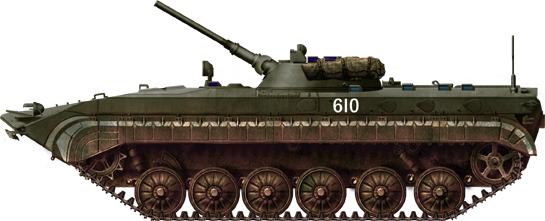
Serial BVP-1 at max elevation in the 1970s
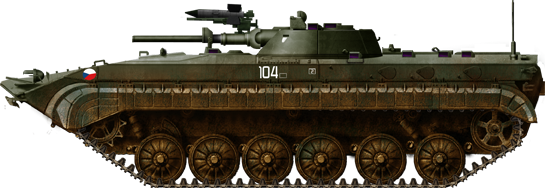
Regular Czechoslovakian BVP-1 in the 1980s
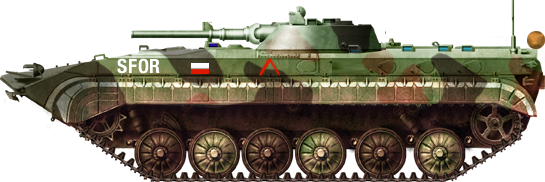
Polish BWP-1
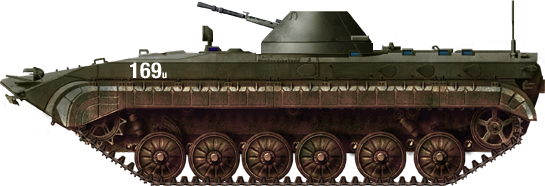
OT-90 APC
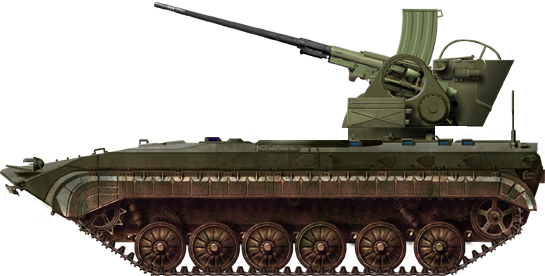
BVP-1 "Strop" SPAAG (initial design)
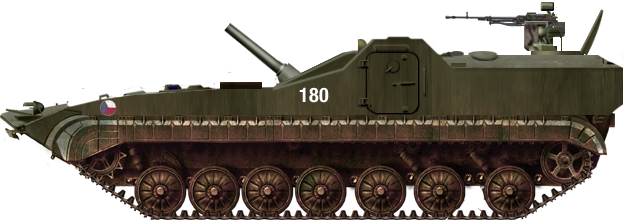
Vz.85 ShM-120 PRAM-S

Syrian BVP-1
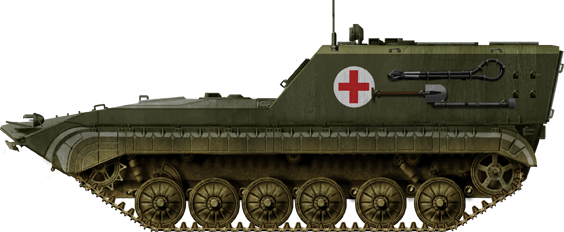
AMB-S
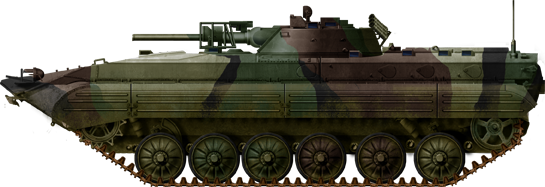
Slovakian BzVP-1 today (likely now in Ukraine)
More photos
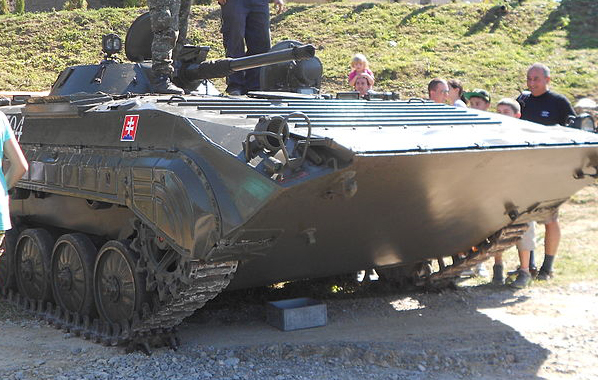
BVP-1 of the Slovak Army
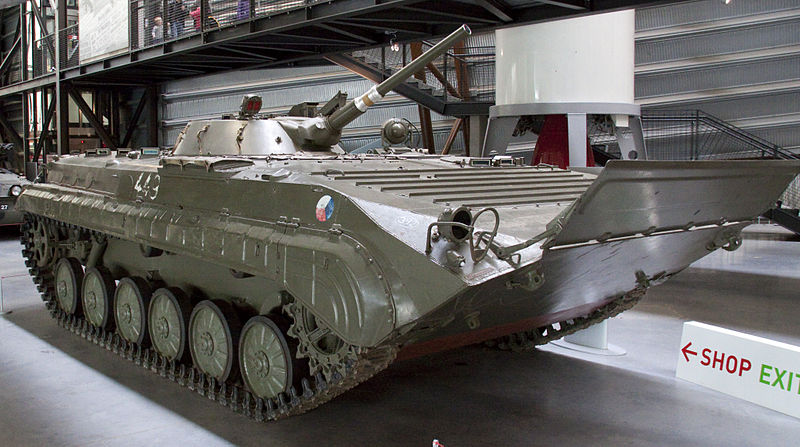
BVP-1 at the RAF museum
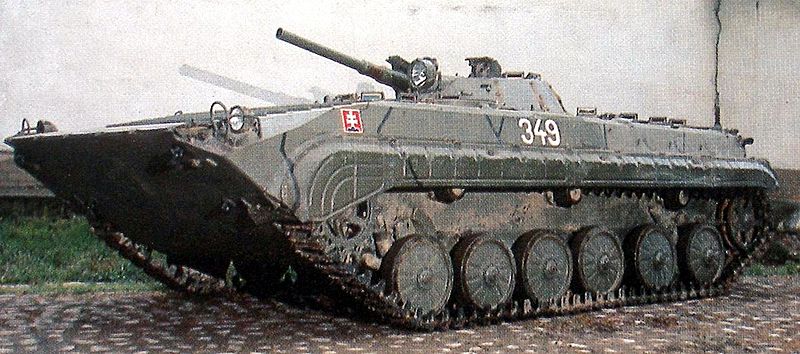
Slovakia army BVP-1
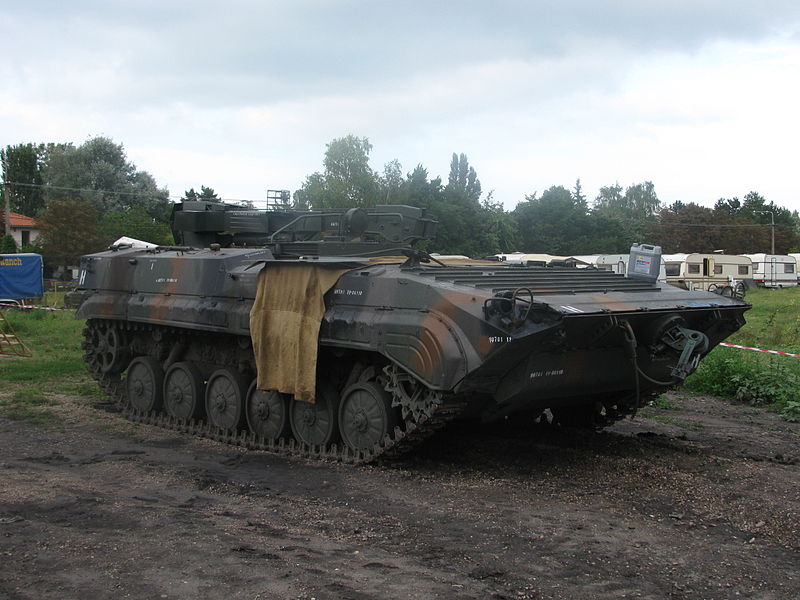
Czech VPV
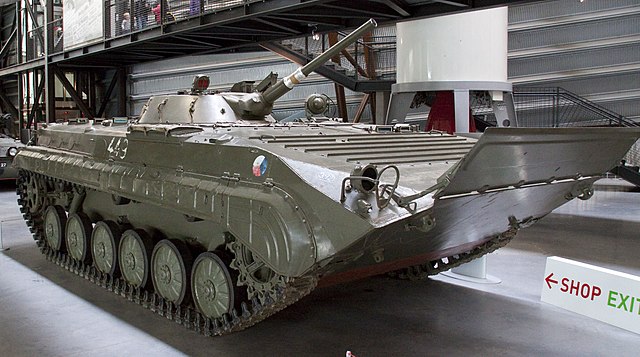
BVP-1 at the RAF museum
Sources
globalsecurity.orgen.topwar.ru
army.cz/
csla.cz
www.armedconflicts.com
commons.wikimedia.org
cs.wikipedia.org
BVP-1 (Al-Nusra Front Syria)
Videos

Cold War Tanks


































Cold war tanks posters

Cold War Main Battle Tanks

Cold War Soviet Army
Museums, Movies, Books & Games
The Tanks and Armor in pop culture
Tanks and armored vehicles in general are only really grasped when seen first person: The mass, the scale, it's all there. Explore also the way tanks were covered in the movie industry, in books and in video games.Movies:
Best tanks movie on warhistoryonline.com
On imdb.com
On bestsimilar.com/
miltours.com
liveabout.com/
watchmojo.com
Video Games:
pcgamesn.com
historyhit.com
levvvel.com
vg247.com/best-tank-games
mmobomb.com/
alienwarearena.com

